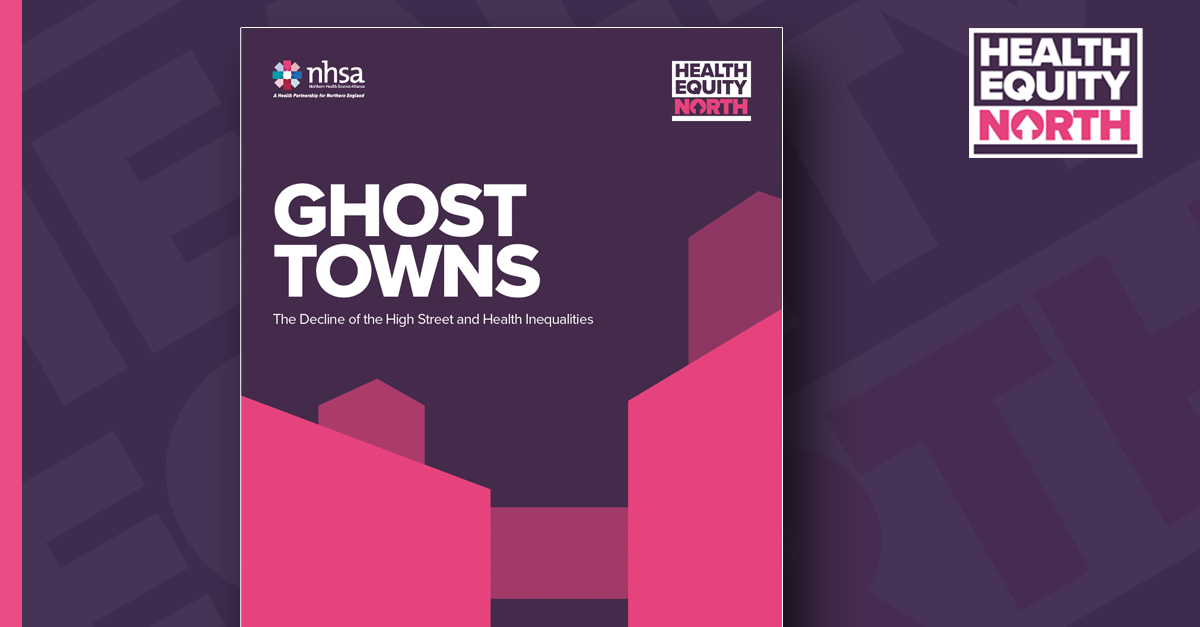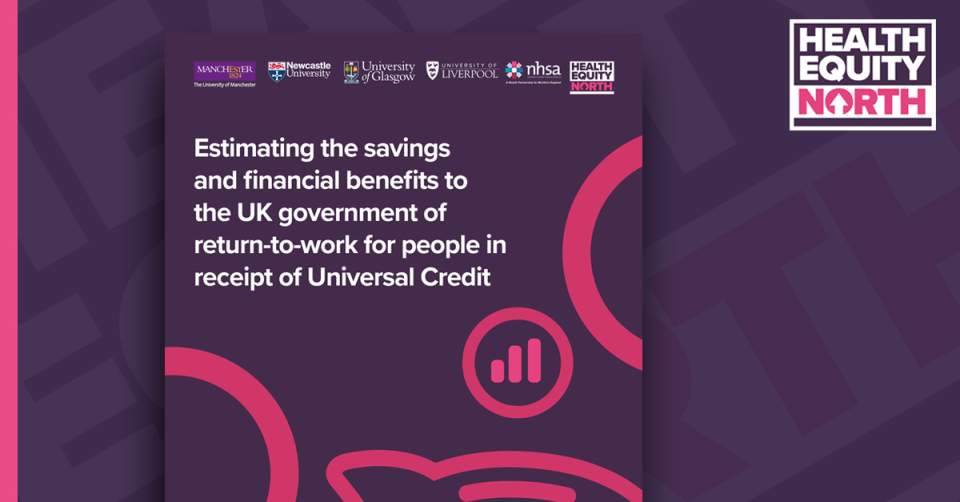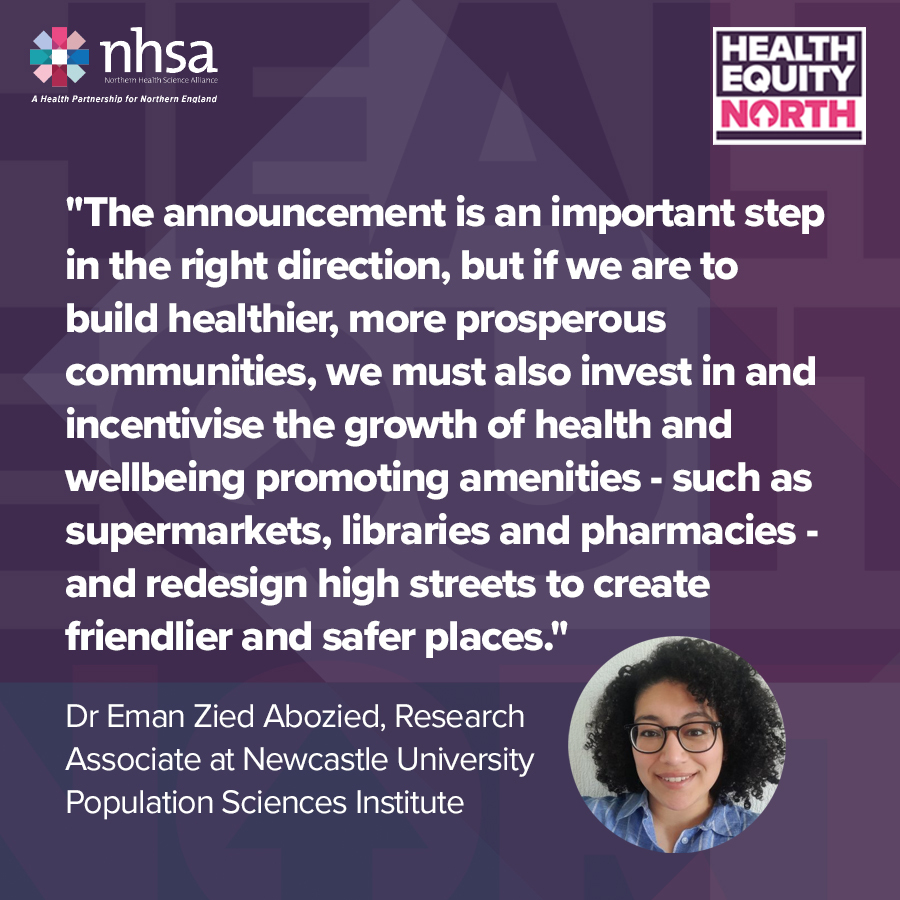Report calls for decisive action to reverse the decline of England’s High Street “Ghost Towns”

Read the report here
The Government needs to take urgent steps to reverse the deterioration of England’s High Streets – particularly in the North, and in more deprived and coastal areas.
A new report published by Health Equity North has found that the quality of the High Street continues to decline across the country – with vital community amenities such as banks, pharmacies, public toilets and supermarkets being replaced by vape shops, bookmakers and takeaway outlets.
This trend has accelerated over the last decade, due to austerity, the pandemic, the rising cost of living, and changing spending habits.
The authors warn that these “Ghost Towns” are making the English High Street a more isolating, unsafe and unhealthy place. They urge the Government to step in to protect places which support the community in our town centres, and to help regulate more unhealthy amenities. The analysis shows that the decline of the high street is particularly stark in deprived areas and areas in the North – places which are already struggling with health and economic inequalities.
The research team, led by Health Equity North academics from Newcastle University and The University of Manchester, set out to catalogue the changing face of High Streets, using ordnance survey data to track the distribution of 16 key amenities between 2014 and 2024.
These include “health promoting” amenities such as pharmacies and supermarkets, and “health reducing” amenities such as takeaways, bookmakers, vape shops and alcohol-only outlets. The authors also observed the availability of “third spaces”, which are described as “places to go which are not home or work”. These include shopping centres, pubs, department stores and cafes.
The report finds that there has been a worrying decline in the quantity of “health promoting” amenities, retail and “third spaces” over the last ten years, with more unhealthy alternatives taking their place. This has been caused by several local and national shocks over the last decade, including shifting consumer habits, austerity, the cost of living crisis, the 2017 “retail apocalypse” and the COVID-19 pandemic.
The report – which you can read in full here – discovered that:
- The number of vape shops increased by nearly 1200% in England between 2014 and 2024
- There are now more than three times more vape shops in deprived areas compared to the least deprived ones
- There are 25 times more pawnbrokers in deprived areas, and more than three times more bookmakers
- Takeaway shops are up by 24% across the whole of England, and by 30% in the most deprived areas
- Conversely, the number of banks and building societies has dropped by 40% nationally, and 57% in the most rural areas
- Pharmacies are down 20% in England’s most deprived areas, compared to 13% in the least deprived
- There was a 38% drop in public toilets in the most deprived areas, compared to a national average decrease of 25%, affecting women, children and the elderly the most
- Supermarkets have also decreased by 22% in deprived areas – compared to a national average decrease of 10%.
These trends are particularly pronounced in northern communities, as well as coastal areas which often suffer from inequality and poorer health outcomes.
Regional findings from the analysis show that:
- There are 12.8 unhealthy takeaway outlets per 10,000 people in the North, compared to 8.9 in the South
- The increase in takeaway outlets in the North is almost double the figure in the South, at 31% compared to 18%
- There has been a 35% rise in takeaways between 2014 and 2024 in the North East, 33% in the North West, and 29% in Yorkshire and the Humber
- There are twice as many vape shops in the North as in the South
- Public toilet provision is down 32% in the North compared to 19% in the South
- The decline in supermarket provision is 23% in Yorkshire and the Humber, 14% in the North East and North West, and just 5% in the South
- The North has seen a decrease of 11% in department stores compared to an 12% increase in the South
- There has been an uneven recovery from the pandemic, with 20% most deprived areas experiencing a reduction of 32% in department stores, compared to an 81% increase in the 20% least deprived areas
- In coastal areas, there is almost double the amount of pawnbrokers, compared to non-coastal areas, as well as a higher amount of bookmakers.
The authors have called on central Government and the Metro Mayors to take steps to save High Streets by helping them adapt to new community needs, rather than return to what they were in the past.
They recommend:
- Empowering local authorities to further regulate more unhealthy amenities such as takeaways, off-licenses, vape shops and bookmakers – especially in deprived areas, coastal areas and areas such as the North
- Incentivising the establishment and maintenance of “third spaces” where people can gather – such as pubs, community centres and libraries
- Investing in turning High Streets into more people-friendly spaces, with seating areas, public toilets and safe pedestrianised spaces to increase footfall
- Involving local communities in decision-making and focusing resources for High Street redesign on the places that need most help.
Dr Eman Zied Abozied, Research Associate at Newcastle University Population Sciences Institute, said: “Our research shows that – all over the country – our High Streets are becoming less healthy and welcoming places to visit. This trend is only getting worse, and it is even more pronounced in traditionally deprived areas, such as the North and coastal areas.
“The disappearance of amenities such as supermarkets, banks, pharmacies and public toilets particularly affects groups such as women, children and the elderly. But what we’re seeing impacts all of us. The deterioration of our High Streets makes our centres feel less safe, less inviting, and ultimately makes us feel more disconnected as communities.
“It is important that we act now to reverse this decline. If we involve local communities in making decisions about their high streets, we can make our high streets and towns more accessible and healthy for everyone.”
Dr Luke Munford, Academic Co-director at Health Equity North and Senior Lecturer in Health Economics at the University of Manchester, said: “People in deprived areas and in the North are already facing worse outcomes. In particular, these communities experience lower life expectancy and higher levels of health inequality, compared to communities in the South.
“The sharp increase in fast food outlets, vape shops, bookmakers and other health-reducing amenities in their towns and cities adds a further risk to their health, and could make the gap between North and South even greater.
“We believe that urgent action is needed to reverse this trend. Local authorities should be empowered to regulate unhealthy amenities, and incentivise places that offer vital services and help communities to thrive.”
Professor Clare Bambra, Academic Co-director at Health Equity North and Professor of Public Health at Newcastle University, said: “Over the last decade, our High Streets have been hit by a devastating succession of shocks – from the impact of austerity to the COVID-19 pandemic. They’ve also been hollowed out by changing spending habits, and the rising cost of living.
“This trend has disproportionately affected the most deprived places in our country. The northern High Street now has fewer places to go to buy essentials, as well as fewer public toilets and other amenities and resources. The North has twice as many vape shops as the South, as well as more takeaway outlets and bookmakers.
“We know the Government is keen to build a greater sense of community in our towns and cities. Which is why we’re inviting them to commit to helping create more vibrant and social High Streets.
“You should be able to walk down a High Street, and feel the uniqueness, culture and identity of that community. Through innovative design, better public transport, and measures that promote people over cars, we can re-think these spaces so they become ‘go-to’s’ rather than ‘ghost towns’.”
Professor Adam Todd, Professor of Pharmaceutical Public Health at Newcastle University, said: “For generations, the High Street has been the beating heart of our towns and cities. Places we can go to shop, eat, meet friends and feel part of our communities.
“Today, our High Streets feel like a shadow of themselves. Community amenities and services such as banks, pharmacies and department stores are vanishing – to be replaced by unhealthy fast food takeaways, vape shops and bookmakers.
“Protecting these spaces for the next generation isn’t just about restoring them to some nostalgic vision of town centres past. We need to respond to changing habits, and offer more pedestrianised and attractive spaces; places where people will want to gather, socialise and enjoy a sense of place.”
The report itself features a detailed statistical breakdown of how the provision of certain amenities has changed in England, across different regions, in coastal and inland areas, and in specific Local Authorities across the North.
Read the full report – ‘Ghost Towns: The Decline of the High Street and Health Inequalities’ – here: https://www.healthequitynorth.co.uk/app/uploads/GHOST-TOWNS-REPORT-EMBARGOED.pdf






